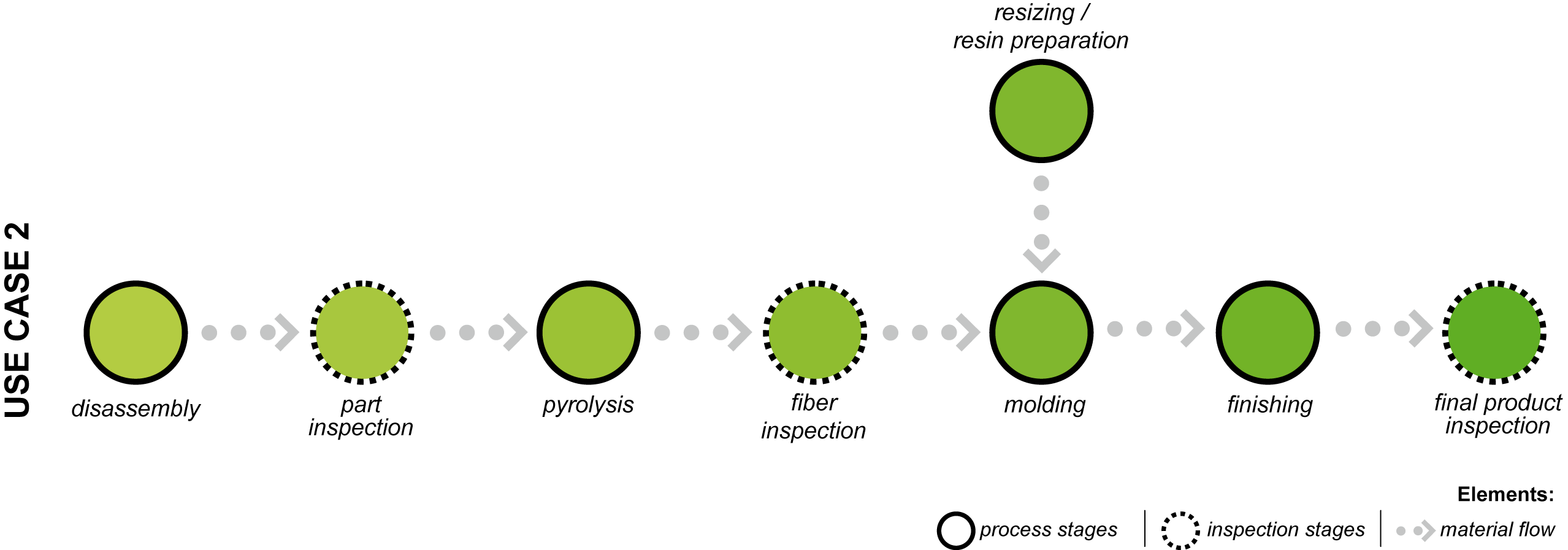Thermal recycling (Use-case 2)
of long fibers (glass and carbon) and re-use in high-tech, high-resistance applications
Input sectors: EoL wind turbines and aerospace components.
Output sectors: automotive aesthetical and structural components, building
Materials and recycling technology: long/medium CF, long/medium GF, thermal recycling Reprocessing: compounding, molding, extrusion.

Description of the problem: The wind energy and the aerospace industrial sectors are currently characterized by the presence of a few large players that dominate the market. In both cases, large volumes of composite materials are involved, with an estimate of about 35,000 tonnes of GFRP and 15,400 tonnes of CFRP annually used on a European scale in the wind energy and aerospace sectors, respectively. In the case of wind energy, in the next 3-5 years the removal and substitution of previously installed wind blades will become an important issue to be considered, as the first commercial wind energy installations are now approaching the end of their lifetime. In particular, it is predicted that by 2034 225,000 tonnes of rotor blade material will need to be recycled annually worldwide. On the other hand, the aerospace industry makes up the most important area of application for CFRP, with a global demand of around 15,400 tonnes of CF. According to predictions from two of the biggest players in the aerospace sector (Boeing and Airbus), the world aircraft fleet is expected to double by 2030, with some 30,000 new airplanes being fabricated (Boeing Current Market Outlook 2013-2033, Airbus Future Journey 2013-2032). In addition, older less efficient airplanes will be replaced with more efficient newer generation airplanes. Considering that CFRP composite structures account for about 30-50% of the total weight of an aircraft (average 12,000 tons), there is a compelling need of managing such large volume of EoL CFRP components. One of the main drivers in this respect is the increasing demand for more efficient and lighter airplanes, in which lay-up manufacturing processes using prepregs have seen a notable increase in the past years (from 37% to 45% in market share). At present, EoL GFRP wind turbine blades are typically landfilled or undergo combustion with energy recovery. As to aerospace CFRP components, their most typical EoL scenario is landfilling.
Description of the solution: An innovative controlled thermal treatment will be exploited for the recovery of GF and CF from EoL parts originating from the wind energy and aerospace sectors. Such process (developed by partner Tecnalia) is based on a low temperature oxygen-free pyrolysis process (<400 ºC) which is able to partially retain the strength and flexibility of the glass and carbon fibers, thus allowing their effective reuse in rGFRP (recycled Glass Fiber Reinfroced Plastics) and rCFRP (recycled Carbon Fiber Reinfroced Plastics). One of the main challenges is to recover both, glass and carbon fiber, as a whole fabric, to be reprocessed by T-RTM (resin transfer molding) technology to produce structural parts. If the EoL component doesn’t allow the recovery of the fibres as a whole fabric, a post-cutting process will be applied to prepare fibres suitable for the compounding process. By means of a tween- screw extruder recycled fibers will be mixed with the selected thermoplastics matrices (PP and PA) to obtain reinforced pellets. The final demonstrators (automotive parts) will be produced by injection molding.
FiberEUse target for these automotive demo-cases (demo-case 1 and demo-case 2) is the replacement of at least 20% of virgin GF and CF with thermally recycled and reformulated GFRP and CFRP in structural components for the automotive sector – e.g. the Clutch Pedal, Front End Carrier and Cowl Top Support show below. In addition, the partner Rivierasca will demonstrate (demo-case 3) reuse of recyceld glass fibers for building components like rooflight panels and valley gutters for tiled and flat roofs. In this application, mechanically recycled GFs cannot be used because of transparency requirements in the final products.Thermally recycled GFs are substantially cleaner (no resin residues), and will be used in extrusion process replacing at least partially virgin fibers.
The main challenges of the Use-case 2 will be
- the optimization of low temperature pyrolysis process to recovery glass and carbon fibers from big composite parts,
- the recovery of GF and CF as fabrics (i.e., long fibers instead short fibers),
- the resizing of recycled fibers,
- the optimization of process parameters to optimize costs.
